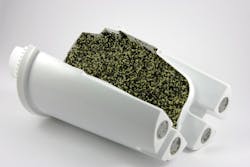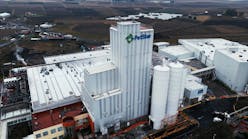About granular activated carbon
Granular activated carbon (GAC) is a hybrid mixture of a wide variety of graphite platelets that are interconnected by nongraphitic carbon bonding. The adsorptive capacity of GAC makes it ideal for removing a variety of contaminants from water, air, liquids and gases. GAC is also an environmentally responsible product that can be reactivated through thermal oxidation and used multiple times for the same application.
The U.S. Environmental Protection Agency (EPA) and most state-based departments of health consider adsorption by GAC to be the best available technology for the removal of many organic materials in surface water. On its own or paired with an ultraviolet (UV) disinfection system, GAC can facilitate the removal of:
- Disinfection byproducts (DBPs) associated with chlorine and alternative disinfectants
- Algal toxins, such as microcystin-LR, cylindrospermopsin and anatoxin-A
- Endocrine-disrupting compounds
- Pharmaceuticals and personal care products
- Taste and odor-causing compounds
- Organic materials from decaying plants and other naturally occurring matter which serve as the precursors for DBPs
The following is a review of the fundamental aspects of activated carbon and specifically the use of GAC as a filter and adsorbent in potable water treatment.
All images courtesy of Calgon Carbon
Activated carbon production
Activated carbons are produced from a wide variety of carbon-rich precursor materials such as bituminous coal, anthracite, subbituminous coal, lignite, wood, coconut shells and peat.
These materials are converted into activated carbon by either thermal or chemical activation processes. Thermal treatment typically includes steam gasification (activation) and chemical activation uses reactive, inorganic additives at relatively lower temperatures.
Activated carbons produced from bituminous coal can be classified as direct activated or reagglomerated. Direct activation involves sizing the coal to approximately the final particle size required and thermally activating the sized coal. Direct activation can produce a less costly product compared to reagglomeration.
The activated carbon production process also yields a structure with a broad range of pore sizes. These pores, or voids, in conjunction with the graphite platelets, generate a material with the strongest physical adsorption forces available in an adsorbent, coupled with the largest volume to store the adsorbed materials.
Adsorption
Adsorption results from the interaction of the electronic structure of an adsorbent, such as activated carbon, with an adsorbate, such as a taste- and odor-causing compound like geosmin. Molecular compounds are kinetically attracted to the porous surface area of the carbon.
Granular activated carbon filtration
GAC has also shown to be an effective physical filtration medium in water treatment plants, and has the added benefit of providing water quality protection by adsorption of taste and odor compounds or chemical contaminants.
Prior to retrofitting an existing multimedia filter with GAC, or designing a new GAC filter, several practical considerations are necessary, including hydraulic requirements, filter on-stream time, and backwash water availability. The properties of the GAC, such as adsorption performance, abrasion resistance and density must be considered as well. Additionally, the effective cost of converting the filter to GAC must be evaluated.
Backwashing requirements are another factor affecting how deep the GAC bed should be, particularly when retrofitting a multimedia filter. The filter design should allow for the optimal expansion while allowing several inches of clearance between the top of the expanded bed and the bottom of the backwash trough. Since the water velocity increases between the troughs, any GAC that is expanded to the level between the troughs will more than likely be washed out of the filter.
The mechanics of installing GAC in a filter retrofit or in a new filter are much the same as for installing sand and anthracite. A notable exception is that the filter and initial gravel/sand or underdrain/sand support must be disinfected prior to installing the GAC. This is because suitable disinfectants, such as chlorine, will rapidly react over GAC, leaving no disinfectant residual. A second variance is the GAC should be submerged for 24 hours prior to the final backwash before bringing the new filter into service. This soak time allows the air entrapped within the GAC pore structure to be removed and it allows the water to thoroughly wet the GAC internal surface.
GAC filter operation recommendations
Conventional GAC filters are sensitive to the same mechanical operating upsets as typical multimedia filters. As a result, the filters should not be subjected to sudden changes in water velocity during production operation, during backwash or startup online. Depending on the filter design, it is recommended that a minimum of 30 seconds is used to bring backwash water to full flow in the filter. When the unit is brought back online, a minimum of 10 minutes is recommended for bringing the filter back to full flow. Operators should account for seasonal water density changes during backwashing and periodically observe a backwash event.
To better maintain the filter, it is recommended that core samples be taken once per year. The purpose of the procedure is to collect an accurate sample from the core of the filter. The GAC can then be tested for residual activity, which is determined using an iodine number test. Historical data suggests that once the iodine number is between 450 and 550, the GAC should be reactivated or exchanged in the near future.
Doug Conley is the marketing manager for Calgon Carbon’s Municipal Business unit. Calgon Carbon is an acknowledged leader in the activated carbon and reactivation industry for many liquid and vapor phase applications, with complementary expertise in ultraviolet disinfection and oxidation, ion exchange technology, and ballast water treatment. Conley may be reached at [email protected].






